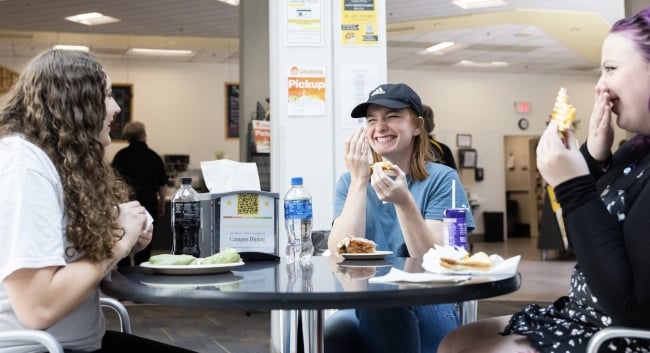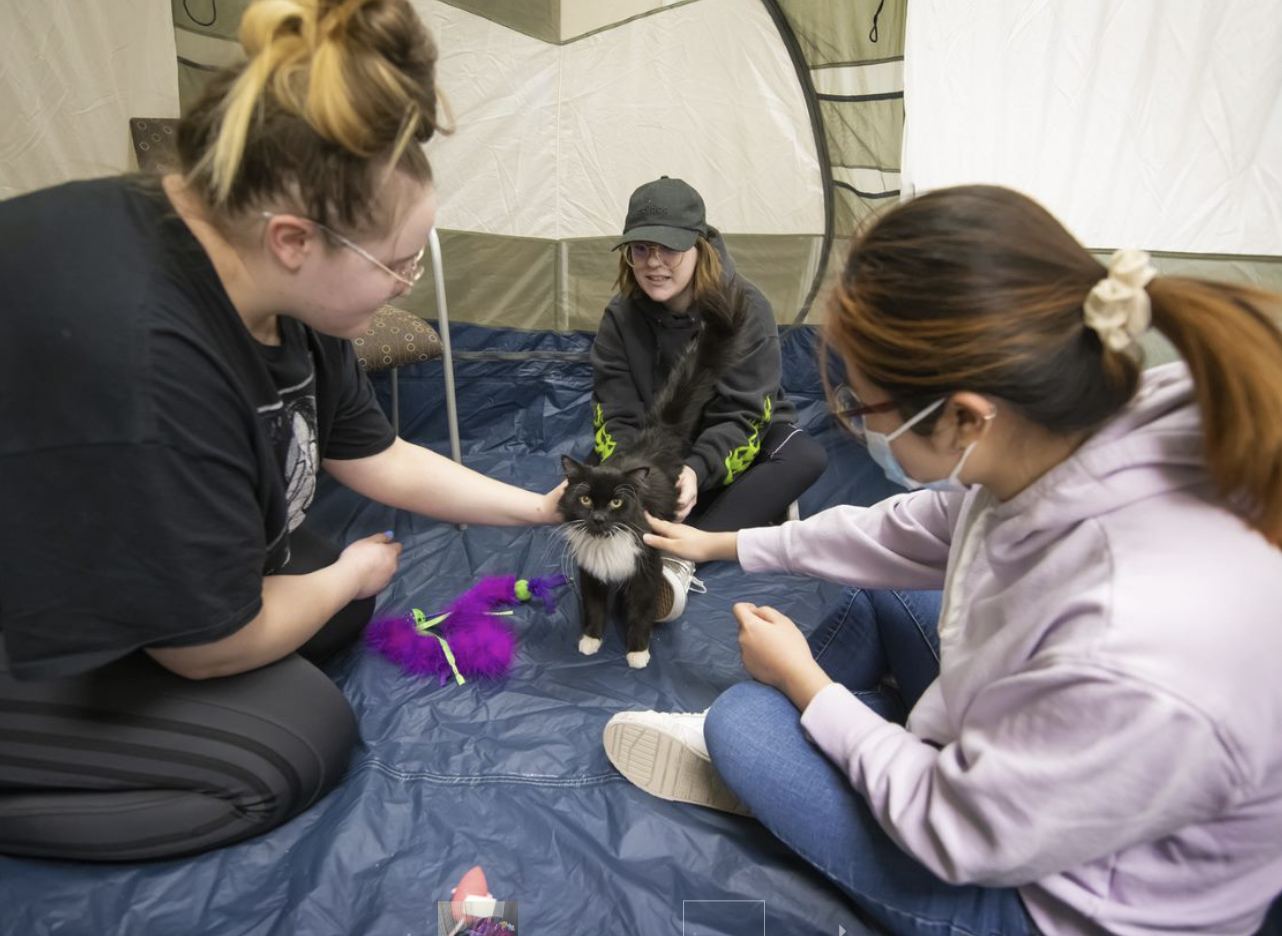You have /5 articles left.
Sign up for a free account or log in.

Students take time out to share a meal at Appalachian State University.
Appalachian State University
The spring Student Voice survey on health and wellness found that college students see room for improvement when it comes to campus dining and wellness programs. A little over half of students agree they have access to campus dining halls when they need and want food, but a quarter of respondents say their college or university is getting dining food hall options right, and just 15 percent are enthusiastic about their campus’s wellness class selection.
But what, precisely, do students mean when they say they want healthier, higher-quality food, and more access to it? Likewise, what are students’ preferred wellness activities, and what would boost their use of these resources? Student Voice, a partnership between Inside Higher Ed and College Pulse, conducted another nationally representative survey of 1,200 four- and two-year college students this month to gain more insight into students’ views on these particular issues.
Results are below. But first, a consideration: certain campus amenities have historically been considered luxuries, and whether and how the flashiest of these amenities contribute to student success remain debated. Amid the collegiate mental health crisis, however, college and university leaders all over are now rethinking their campus environments and student well-being programs in order to get “upstream” of the problem (to quote Kevin Kruger, president of the National Association of Student Personnel Administrators). That is to say, food options and offerings like wellness classes may be a bigger part of the student success puzzle than long thought.
Jack Donovan, president of Aramark’s collegiate hospitality division, which works with dining facilities at more than 250 colleges and universities, for example, says that his organization researched the ideal student dining experience post-pandemic and found it’s about social connection and stability.
Students’ needs and tastes can and do change from day to day, and even within the day, he continues. Students are increasingly plant-forward in their food interests; subscribe to a notion of health that is about mind, body and planet; and seek food experiences that are either highly efficient or highly experiential. Food security is also of concern for many in terms of accessibility.
But a common, consistent desire among students is “this home away from home. That notion of, ‘I feel grounded with people that know me, and even though I’m away from home and on this adventure, I want something that calms me and gives me a touchstone that I can count on.’”
Students’ Priorities for Improving Campus Dining
When it comes to improving the quality of dining hall food on campus, what should colleges and universities prioritize? In the new survey, students’ top response is variety and quality of flavors, with about two in five respondents choosing this as a top-three priority, out of 10 options. Fewer ultra-processed foods is next, at nearly two in five students. A third say variety of cuisines, and about a quarter each say local ingredients, organic ingredients and low-sugar foods.
One in five students each says colleges should prioritize customization or made-to-order meals, detailed labeling of ingredients and seasonal menus. About one in 10 students wants to see a commitment to fair trade ingredients.
Results are relatively consistent across demographic groups and institution types.
Asked what colleges and universities should prioritize when it comes to improving access to dining hall food on campus, almost half of students select affordability from a list of 10 options (with up to three responses allowed). Being open early mornings and late nights also matters to nearly half of students. Approximately two in five students say institutions should improve access to food by being open continuously throughout the day.
About a quarter of students each say colleges should prioritize replenishing items though the day or offering to-go meals. One in five students says colleges should prioritize convenient food service locations. Same for ability to use dining points or dollars across campus.
Nearly one in 10 students each would prioritize detailed labeling of ingredients to assist with dietary restrictions or food delivery to locations on campus.
Students with financial aid are not more likely than those without to say institutions should prioritize food affordability, but students on financial aid are slightly more likely to say colleges should prioritize the ability to use dining points or dollars across campus (21 percent versus 15 percent, respectively).
Students at public institutions, meanwhile, are more likely than students at private institutions to cite affordability as a food-access priority, at 51 percent versus 39 percent, respectively. And affordability is a priority to relatively more two-year students than four-year, at 62 percent versus 45 percent.
Jewish and Muslim students are much more likely than the sample over all and more likely than other religious groups to prioritize detailed food labeling for dietary restrictions, at 21 percent and 25 percent, respectively.
Male students are more likely than female students say colleges should prioritize dining halls being open continuously throughout the day to improve food access, at 45 percent versus 35 percent, respectively.
Students at private institutions are more likely to prioritize to-go meal offerings than students at publics (32 percent versus 19 percent, respectively), as are LGBTQIA+ students relative to straight students (29 percent versus 18 percent, respectively).
Elizabeth Riede, executive director of campus dining at Appalachian State University, which serves at least 10,000 people per day, says she and her team rely on a campus dining advisory board of meal-plan holders, digital surveys and other regular feedback to stay current on students’ tastes, preferences and needs. This coming year, App State is also launching a QR code–driven customer experience survey that will allow students to take pictures of and otherwise comment on their food.
Improving dining offerings and access can do more than boost satisfaction. Meals matter, Riede says, in that they’re “important opportunities to build and develop community,” not least for first-year students.
App State students also care about sourcing local and sustainable food, and this remains a university commitment, Riede notes. Similarly, the university is committed to helping the increasing number of students who report navigating dietary restrictions due to allergies or other medical issues.
Like Donovan, Riede has noticed students are increasingly plant-forward. In response to such concerns, App State has added options including a food station focused on whole foods, prepared to order by an allergy-trained chef, with a menu geared toward accommodating the “big nine” allergies.
At the same time, students want more to-go style meals, with mobile ordering and pickup, she adds. Riede says App State is one of only two self-operating dining programs in North Carolina’s public university system, which allows it “more flexibility to respond to the changing needs of our students,” including affordability.
“For us, it really does start with them,” Riede says of students. “We are first and foremost in the customer service business, and we see ourselves as an integral part of their college experience.”
Students’ Preferred Wellness Activities and Barriers to Access
What are students’ preferred wellness activities or resources, whether or not those options exist on their campus? The top response by far is going to the gym, at nearly three in five respondents (who could select up to three of 15 options). About a quarter of students each like the following activities: groups walks or hikes, exercise classes, recreational sports, or yoga classes.
Nearly one in five students prefers cooking workshops or therapy dog events. About one in 10 students prefers art therapy classes, mindfulness and meditation classes or workshops, or stress management workshops.
Four-year college students are more likely to prefer going to the gym than are two-year college students (60 percent versus 47 percent, respectively) and to like group walks and hikes (30 percent versus 21 percent).
Relatively more men than women prefer going to the gym (68 percent versus 51 percent, respectively) and recreational sports (32 percent versus 17 percent).
Women, meanwhile, are more likely than men to prefer exercise classes (31 percent versus 21 percent), yoga (29 percent versus 12 percent) and art therapy classes (15 percent versus 5 percent).
LGBQTIA+ students are less likely than straight peers to prefer exercise classes (19 percent versus 29 percent, respectively) and recreational sports (16 percent versus 26 percent) but more likely to prefer therapy dog events (22 percent versus 15 percent) and mindfulness and meditation classes or groups (17 percent versus 8 percent).
Going to the gym is more popular among students in small to large cities (n=850), at 60 percent of respondents, than among suburban or rural respondents (n=400), at 52 percent.
Asked which of several factors would allow them to use more wellness facilities and resources on their campus, 40 percent of students choose hours that fit their schedules. Proximity is next, at 31 percent of respondents.
Twelve percent of students each say variety of offerings and quality of facilities would boost their use of wellness facilities. Four percent of students say none of these factors would make them use more campus wellness facilities and resources.
Students with financial aid are more likely than those without to say hours that fit their schedule matter most, at 41 percent versus 34 percent, respectively. Four-year college students are more likely than two-year students to say proximity matters most, at 32 percent versus 25 percent, respectively.
For students attending institutions in large urban areas (n=311), proximity is the No. 1 factor that would boost their use of wellness facilities and resources, at 36 percent of respondents. Students at institutions in small to medium cities, suburban and rural areas all rank hours that fit with their schedules as most important.
Jennifer Knerr, assistant director of the Wellness Center at the University of Wyoming—a free facility within the campus fitness center featuring everything from a Zen den and an immersive wellness pod to health seminars and free contraceptives—says, “We want to have something for everyone. We want to be a place for everyone. And so we do try to offer that wide variety of programming, where we might catch this group of people, and then another program that might catch this group of people and pull them into our Wellness Center.”
Knerr says the center’s most popular offerings are its massage chairs and its puppy playdates and kitty cuddle times. Yet Knerr and her colleagues define wellness as much more comprehensive than massages or fighting stress with cute animals. It’s a multidimensional concept touching on physical, intellectual, emotional, social, occupational, environmental, spiritual and financial health, all of which are connected.

Kitty cuddles is a popular program for students at the University of Wyoming’s Wellness Center.
University of Wyoming
“It’s an active process and it’s associated with your intentions, choices and actions, and it can change from day to day or year to year,” Knerr says. “I also let students know wellness is individual, because your wellness is not my wellness—like your wellness might be taking a nap and my wellness might be going for a walk. So we try to be really individualized as well as offer a lot of different programs.”
Erin Patchett, director of administration and assessment for campus recreation at Colorado State University and board member of NIRSA, an organization of leaders in college recreation, says that many of her efforts are about creating an inclusive recreation environment for everyone on campus. (The department’s #WeREC campaign is about respecting boundaries, empowering oneself and one’s friends, and caring about each other, for example).
When it comes to recreation, Patchett says, “there’s a focus on the physical piece, moving your body and hopefully finding joy in movement,” in addition to stress relief and balance. But there is also a “a big sense of belonging connected to these efforts. Participating in recreation services and facilities can often help people find their community on a campus.”





